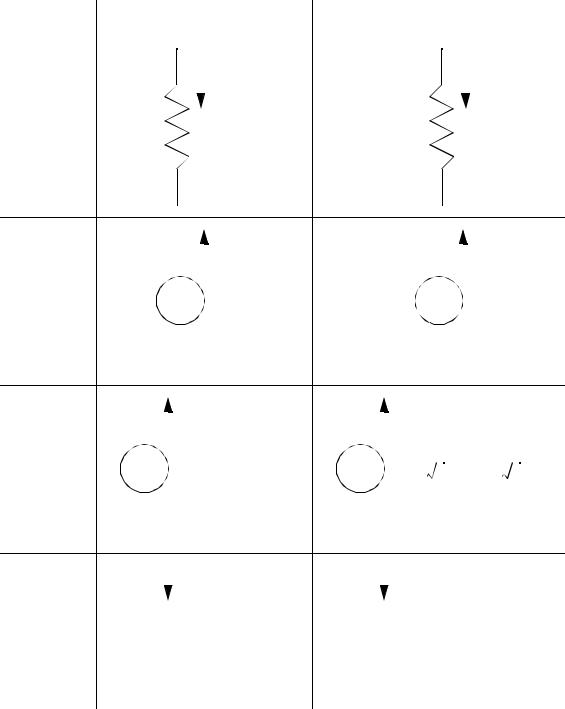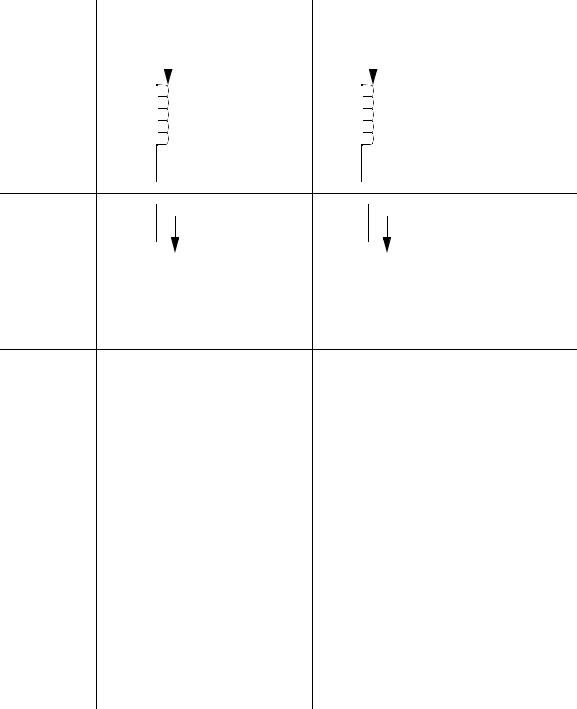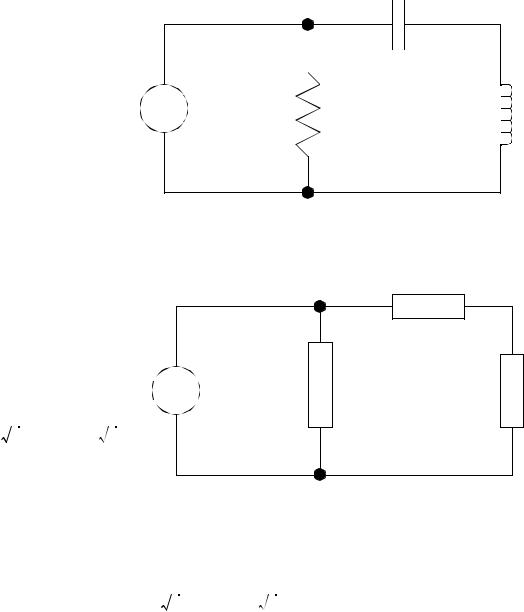
- •1. TABLE OF CONTENTS
- •2. BASIC CIRCUIT ANALYSIS
- •2.1 CIRCUIT COMPONENTS AND QUANTITIES
- •2.2 CIRCUIT DIAGRAMS
- •3. CIRCUIT ANALYSIS
- •3.1 KIRCHOFF’S LAWS
- •3.1.1 Simple Applications of Kirchoff’s Laws
- •3.1.1.1 - Parallel Resistors
- •3.1.1.2 - Series Resistors
- •3.1.2 Node Voltage Methods
- •3.1.3 Current Mesh Methods
- •3.1.4 More Advanced Applications
- •3.1.4.1 - Voltage Dividers
- •3.1.4.2 - The Wheatstone Bridge
- •3.1.4.3 - Tee-To-Pi (Y to Delta) Conversion
- •3.2 THEVENIN AND NORTON EQUIVALENTS
- •3.2.1 Superposition
- •3.2.2 Maximum Power Transfer
- •3.3 CIRCUITS CONTAINING CAPACITORS AND INDUCTORS
- •4. PASSIVE DEVICES
- •4.1 TRANSFORMERS
- •5. ACTIVE DEVICES
- •5.1 OPERATIONAL AMPLIFIERS
- •5.1.1 General Details
- •5.1.2 Simple Applications
- •5.1.2.1 - Inverting Amplifier
- •5.1.2.2 - Non-Inverting Amplifier
- •5.1.2.3 - Integrator
- •5.1.2.4 - Differentiator
- •5.1.2.5 - Weighted Sums
- •5.1.2.6 - Difference Amplifier (Subtraction)
- •5.1.2.7 - Op-Amp Voltage Follower
- •5.1.2.8 - Bridge Balancer
- •5.1.2.9 - Low Pass Filter
- •5.1.3 Op-Amp Equivalent Circuits
- •5.1.3.1 - Frequency Response
- •5.2 TRANSISTORS
- •5.2.1 Bipolar Junction Transistors (BJT)
- •5.2.1.1 - Biasing Common Emitter Transistors
- •6. AC CIRCUIT ANALYSIS
- •6.1 PHASORS
- •6.1.1 RMS Values
- •6.1.2 LR Circuits
- •6.1.3 RC Circuits
- •6.1.4 LRC Circuits
- •6.1.5 LC Circuits
- •6.2 AC POWER
- •6.2.1 Complex Power
- •6.2.1.1 - Real Power
- •6.2.1.2 - Average Power
- •6.2.1.3 - Reactive Power
- •6.2.1.4 - Apparent Power
- •6.2.1.5 - Complex Power
- •6.2.1.6 - Power Factor
- •6.2.1.7 - Average Power Calculation
- •6.2.1.8 - Maximum Power Transfer
- •6.3 3-PHASE CIRCUITS
- •7. TWO PORT NETWORKS
- •7.1 PARAMETER VALUES
- •7.1.1 z-Parameters (impedance)
- •7.1.2 y-Parameters (admittance)
- •7.1.3 a-Parameters (transmission)
- •7.1.4 b-Parameters (transmission)
- •7.1.5 h-Parameters (hybrid)
- •7.1.6 g- Parameters (hybrid)
- •7.2 PROPERTIES
- •7.2.1 Reciprocal Networks
- •7.2.2 Symmetrical Networks
- •7.3 CONNECTING NETWORKS
- •7.3.1 Cascade
- •7.3.2 Series
- •7.3.3 Parallel
- •7.3.4 Series-Parallel
- •7.3.5 Parallel-Series
- •8. CAE TECHNIQUES FOR CIRCUITS
- •9. A CIRCUITS COOKBOOK
- •9.1 HOW TO USE A COOKBOOK
- •9.2 SAFETY
- •9.3 BASIC NOTES ABOUT CHIPS
- •9.4 CONVENTIONS
- •9.5 USEFUL COMPONENT INFORMATION
- •9.5.1 Resistors
- •9.5.2 Capacitors
- •9.6 FABRICATION
- •9.6.1 Shielding and Grounding
- •9.7 LOGIC
- •9.8 ANALOG SENSORS
page 57
6. AC CIRCUIT ANALYSIS
•There are a number of techniques used for analysing non-DC circuits.
•These techniques are,
-phasors - for single frequency, steady state systems
-laplace transforms - to find steady state as well as transient responses
-etc
6.1 PHASORS
•Phasors are used for the analysis of sinusoidal, steady state conditions.
•Sinusoidal means that if we measure the voltage (or current) at any point ‘i’ in the circuit it will have the general form,
Vi( t) = Vipeak sin ( ω it + φ i)
where, |
|
|
|
|
i |
= a node number |
|||
Vi( t) |
= |
the instantaneuous voltage at node i |
||
Vipeak |
= |
the peak voltage at node i |
||
ω |
i |
= |
the frequency of the sinusoid |
|
φ |
i |
= |
the phase shift |
|
•Steady state means that the transients have all stopped. This can be crudely though of as the circuit has ‘charged-up’ or ‘warmed-up’.
•Consider the example below,

page 58
+
R1 V1
-
-
Vs +
+
R2 V2
-
Considering that this is a simple voltage divider,
V |
|
= ( –V ) |
|
|
R2 |
|
----------------- |
||||
|
2 |
s |
R |
1 |
+ R |
|
|
|
|
2 |
|
If the supply voltage is sinusoidal we would find,
Vs |
|
= 95 sin ( 10t + 0.3) |
|
|
|
|
|
||
|
V |
|
= ( –95 sin ( 10t + 0.3) ) |
|
|
R2 |
|
||
|
------------------ |
||||||||
|
|
|
2 |
|
R |
|
+ R |
|
|
|
|
|
|
|
|
1 |
|
2 |
|
|
V |
|
|
= ( 95 sin ( 10t + 0.3 – π ) ) |
|
|
R2 |
|
|
|
|
----------------- |
|||||||
|
|
2 |
|
|
R + R |
||||
|
|
|
|
|
|
|
1 |
|
2 |
• Steady state is another important concept, it means that we are not concerned with the initial effects when we start a circuit (these effects are known as the transients). The typical causes of transient effects are inductors and capacitors.

page 59
V(t) |
t |
steady state + transients |
steady state |
• We typically deal with these problems using phasor analysis. In the example before we had a voltage represented in the time domain,
Vs = 95 sin ( 10t + 0.3)
We could also represent this in the polar domain using magnitude and phase shift. These Phase diagrams are only applicable for a single frequency. Note: the peak value is divided by the square root of 2 to convert it to an RMS value.
|
95 |
|
|
|
|
------V |
|
|
|
|
2 |
|
|
|
|
|
OR |
95 |
· |
|
|
Vs = ------V |
0.3rad |
|
|
0.3rad. |
2 |
|
|
|
|
|
|
|
|
|
|
|
|
|
|
|
|
|
Finally, we could represent the values in complex form,
imaginary
95 |
Vs |
= |
95 |
jφ |
} |
------V{ e |
|
||||
------V |
|
|
2 |
|
|
2 |
|
|
|
|
|
|
|
95 |
|
|
|
|
= |
|
|
||
|
------V{ cos ( 0.3rad) + j sin ( 0.3rad)} |
||||
0.3rad. |
|
|
2 |
|
|
|
|
|
|
|
|
 real
real

page 60
NOTE: When doing phasor analysis, it is assumed that all of the frequencies in the circuit are the same, and they only differ by a phase angle.
• Basically to do this type of analysis we represent all components voltages and currents in complex form, and then do calculations as normal.

page 61
|
TIME DOMAIN |
PHASOR (FREQUENCY) DOMAIN |
|||||
|
|
|
|
|
|
|
|
RESISTOR |
|
I |
|
|
|
I |
|
|
|
|
|||||
|
|
|
|
|
|
||
+ |
|
|
+ |
|
|
|
|
|
|
|
|
|
|||
|
V |
|
|
V |
|
|
|
- |
R |
- |
Z = R |
||||
DC VOLTAGE |
|
|
I |
|
|
I |
|
|
|
|
|||
SOURCE |
Vs |
|
|
Vs |
|
|
|
|
|
|
|||
|
|
|
|
|
||
|
|
+ |
|
|
+ |
|
|
|
- |
|
|
- |
|
|
|
|
|
|
|
|
AC VOLTAGE |
|
I |
|
|
I |
|
|
|
|
|
|
|
|||
SOURCE |
|
Vs = A sin ( ω t + φ ) |
|
V |
|
A |
A |
|
|
|
|||||
|
|
|
|
||||
|
+ |
+ |
s |
= ------ cos φ |
+ j------ sin φ |
||
|
|
|
2 |
2 |
|||
|
- |
|
- |
|
|
||
|
|
|
|
|
|
||
|
|
|
|
|
|
|
|
CAPACITOR |
|
|
I |
|
|
|
I |
|
|
|
|
|
|
|
|
|
|||||
+ |
|
|
|
d |
+ |
|
|
Z = |
|
1 |
V |
|
|
|
C----V = I |
V |
|
|
--------- |
||
|
|
dt |
|
|
jω |
C |
||||
|
|
|
|
|
|
|||||
- |
|
|
|
|
- |
|
|
|
|
|
|
|
|
|
|
|
|
|
|
|
|

page 62
|
TIME DOMAIN |
PHASOR (FREQUENCY) DOMAIN |
|||||
|
|
|
|
|
|
|
|
INDUCTOR |
|
|
I |
|
|
I |
|
|
|
|
|
||||
|
|
|
|||||
+ |
|
|
d |
+ |
|
Z = jω L |
|
|
|
|
|||||
|
V |
|
V = L----I |
V |
|||
|
|
dt |
|
||||
- |
|
|
- |
|
|
||
|
|
|
|
|
|||
OHM’S LAW
+ |
|
|
I |
+ |
|
|
I |
|
|
|
|
||||
|
|
V = IR |
|
|
V = IZ |
||
V |
|
|
V |
|
|
||
|
|
|
|
|
|
||
- |
|
|
|
- |
|
|
|
|
|
|
|
|
|
|
|
• Consider the simple example below,

page 63
|
|
10µ F |
|
|
+ |
5Ω |
+ |
|
|
||
|
- |
5mH |
Vo |
|
|
- |
|
Vs |
= 5 sin ( 10000t + 0.5) |
|
|
|
|
We can redraw the diagram using impedances for each component,
|
|
|
|
Z2 |
= |
1 |
|
|
|
|
|
-------------------------------- |
|
||
|
|
|
|
|
|
j( 10000) 10–5 |
|
|
|
|
|
Z1=5Ω |
|
|
|
|
|
|
+ |
|
|
|
+ |
|
|
5 |
- |
Z3 |
= j( 10000) 0.005 |
Vo |
|
|
|
5 |
- |
||||
Vs |
= |
------ sin ( 0.5) + j------ cos ( 0.5) |
|
|
|
|
|
|
|
2 |
2 |
|
|
|
|
Then, as if the circuit is only made of resistors, we procede to use standard circuit analysis techniques,
|
|
|
|
|
|
|
|
|
|
|
|
|
|
|
Z3 |
|
|
5 |
|
5 |
|
|
j( 10000) 0.005 |
|
|
Vo = Vs Z----------------- |
2 |
+ Z |
= |
|
------2 |
sin ( 0.5) + j |
------2 |
cos ( 0.5) |
|
--------------------------------------------------------------------------1 |
|
|
|
3 |
|
|
|
|
|
-------------------------------- |
|
|
|||
|
|
|
|
|
|
|
|
|
|
j( 10000) 10–5 |
+ j( 10000) 0.005 |
|
|
Vo |
|
( j( 10000) 0.005) ( j( 10000) 10–5) |
|
= ( 3.11 + j1.70) |
--------------------------------------------------------------------------------------- |
|
||
|
|
|
1 + ( j( 10000) 0.005) ( j( 10000) 10–5) |
|
|
Vo |
= ( 3.11 + j1.70) |
|
5 |
|
= |
{ – 3.89 – j2.13} V = 4.43V –2.07rad |
|
|
1-----------– |
5 |
||||||
|
|
|
|
|
If we express the output voltage as a function of time we get,
Vo( t) = 4.43 sin ( 10000t – 2.07) V
